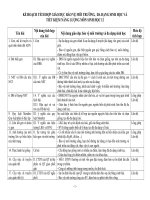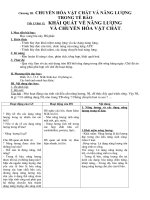- Trang chủ >>
- Sư phạm >>
- Sư phạm văn
Tiết kiệm-xử lý năng lượng trong kiến trúc
Bạn đang xem bản rút gọn của tài liệu. Xem và tải ngay bản đầy đủ của tài liệu tại đây (199.83 KB, 4 trang )
<span class='text_page_counter'>(1)</span><div class='page_container' data-page=1>
<i><b>Int.J.Curr.Microbiol.App.Sci </b></i><b>(2017)</b><i><b> 6</b></i><b>(11): 1131-1134 </b>
1131
<b>Original Research Article </b>
<b>Microsatellite Marker Based DNA Fingerprinting for Parentage </b>
<b>Verification in Goat Breeds of Kashmir </b>
<b>Rumase A. Bhat1*, Mehraj uddin Reshi2, Sajad A. Beigh1, Wani A. Ahad1, </b>
<b>Tarique A. Padder2, Nazir A. Ganai3, Mudasir Andrabi1 and Riaz A. Shah1</b>
1
Division of Animal Biotechnology, Faculty of Veterinary Sciences and Animal Husbandry,
Shuhama, Alasteng, Ganderbal, SKUAST-Kashmir, India
2
Faculty of Veterinary Sciences and Animal Husbandry, Shuhama, Alasteng, Ganderbal,
SKUAST-Kashmir, India
3
Division of Animal Breeding and Genetics, Faculty of Veterinary Sciences and Animal
Husbandry, Shuhama, Alasteng, Ganderbal, SKUAST-Kashmir, India
<i>*Corresponding author </i>
<i> </i>
<i><b> </b></i> <i><b> </b></i><b>A B S T R A C T </b>
<i><b> </b></i>
<b>Introduction </b>
Correct pedigree recording is essential for
genetic improvement programs in livestock
species. Pedigree errors of about 10% may
lead to reductions in selection response of two
to three percent in dairy cattle (Visscher <i>et al.,</i>
2002), while different studies have reported
pedigree errors of up to 23% in cattle in
several countries (Jiménez-Gamero <i>et al.,</i>
2006). Goats are primarily farmed under
extensive production systems and mating
systems used by breeders taking part in the
Stock Improvement Schemes primarily
include group mating and flock mating. These
mating practices limit accurate pedigree
recording. Other factors that contribute to
potential errors in identification of the parents
include the use of large paddocks in extensive
production systems (Bolormaa <i>et al.,</i> 2008).
So, correct parentage among breeding stock is
a pre-requisite for an efficient breeding
programme. Besides, parentage analysis finds
its importance in paternity disputes in
<i>International Journal of Current Microbiology and Applied Sciences </i>
<i><b>ISSN: 2319-7706</b></i><b> Volume 6 Number 11 (2017) pp. 1131-1134 </b>
Journal homepage:
Bhakerwal and Pashmina are local Kashmiri goat breeds usually reared by
nomadic people and people of Changthang region of Ladakh respectively.
They play promising role in alleviating poverty of this far flung region of
the country. Adequate breeding and research have been done in these
animals to increase their population and quality but parentage analysis and
pedigrees record keeping has been a limitation since long time. Keeping
this in view the present study was conducted to validate a panel of 8
microsatellite markers in 10 families of Bhakerwal and Pashmina breeds so
that this limitation can be overcome and breeding and research of these
breeds could be carried prudently in future.
<b>K e y w o r d s </b>
Microsatellites,
Parentage analysis,
PIC, Non-Exclusion
probability.
<i><b>Accepted: </b></i>
10 September 2017
<i><b>Available Online:</b></i>
10 November 2017
</div>
<span class='text_page_counter'>(2)</span><div class='page_container' data-page=2>
<i><b>Int.J.Curr.Microbiol.App.Sci </b></i><b>(2017)</b><i><b> 6</b></i><b>(11): 1131-1134 </b>
1132
animals. The markers revealing variation at
DNA sequence level are referred as DNA
markers which can be Restriction Fragment
Length Polymorphism (RFLP), Randomly
Amplified Polymorphic DNA (RAPD),
Amplified Fragment Length Polymorphism
(AFLP), Single Nucleotide Polymorphism
(SNP), Variable Number Tandem Repeats
(VNTRs) and Simple Sequence Repeats
(SSRs).
Microsatellite markers are used nowadays for
DNA fingerprinting which are DNA
sequences of one to six units repeated in
tandem. Microsatellite markers are ideal for
parentage verification because they are
randomly distributed throughout the genome,
commonly occurring in noncoding regions,
and are selectively neutral. Microsatellite
alleles also show codominant inheritance,
making them relatively easy to score directly.
Microsatellites can be identified by PCR
amplification followed by amplicon scoring.
Amplicon scoring can be performed by
amplicon sequencing, radiolabelled primers
(probes), fluorescent dye labelled primers,
metaphor gel electrophoresis or by
denaturation or native PAGE. Using any of
the above mentioned method the exact size of
amplicon of different alleles is obtained
which can be used for parentage verification.
<b>Materials and Methods </b>
The present investigation was undertaken on
ten families of Bhakerwal and Pashmina goats
maintained at Mountain Research Centre of
Sheep and Goat, F.V.Sc and A.H, Shuhama,
Alasteng. Genomic DNA was isolated from
the blood samples using the standard
Phenol-Chloroform extraction protocol of Sambrook
and Russell (2001) Microsatellite markers as
listed in Table 1 were used for amplification
of DNA samples of the germplasm under
investigation.
PCR was carried out in a final reaction
volume of 20 μl in 200 μl thin walled
sterilized PCR tubes. All conditions were
same for 8 microsatellite markers except the
annealing temperature. Annealing
temperature for ILSTS-019, ILSTS-022,
ILSTS-030, MAF214, oarJMP58, BM4301
and INRA081 was 58°C, whereas annealing
temperature for oarAE129 was 60°C. The
PCR amplicons were further separated on 3%
metaphor agarose gel electrophoresis to
determine allelic variation at each locus. For
statistical analysis Mean number of alleles,
Polymorphism Information Content (PIC),
Heterozygosity (Observed and Expected)
were calculated using GenAlEx software.
These parameters were used for determination
of non-exclusion probability utilising the
software Cervus 3.0.
<b>Results and Discussion</b>
</div>
<span class='text_page_counter'>(3)</span><div class='page_container' data-page=3>
<i><b>Int.J.Curr.Microbiol.App.Sci </b></i><b>(2017)</b><i><b> 6</b></i><b>(11): 1131-1134 </b>
1133
<b>Table.1 </b>Primer sequences for different microsatellites used for DNA fingerprinting
S. No <b>Microsatellite</b> <b>Markers Primer sequences (5′-3′)</b> <b>Reference </b>
1 BM4301 <b>F:</b> CCACATGTCTCAAAGCAACG
<b>R:</b> GGAAAAGGGTCTTTGTTGAGC
Stone <i>et al., </i>(1995)
2 INRA081 <b>F: </b>CGGCTCACGGTCTCTATCGG
<b>R:</b>GCGAACCCAAGAATCAGACTC
Ihara<i>et al.,</i>(2004)
3 MAF214 <b>F</b>:AATGCAGGAGATCTGAGGCAGG
<b>R:</b> CCACTCCTCCTGAGAATATAACATG
Buchanan <i>et </i> <i>al.,</i>
(1992)
4 ILSTS-022 <b>F:</b> TCTATACACATGTGCTGTGC
<b>R:</b> CTTAGGGGTGAAGTGACACG
Kemp <i>et al., </i>(1995)
5 oarJMP58 <b>F:</b>GAAGTCATTGAGGGGTCGCTAACC
<b>R:</b>CTTCATGTTCACAGGACTTTCTCTG
Lumsden <i>et </i> <i>al., </i>
(1996)
6 ILSTS-019 <b>F:</b> AAGGGACCTCATGTAGAAGC
<b>R:</b> ACTTTTGGACCCTGTAGTGC
Kemp <i>et al., </i>(1993)
7 ILSTS-030 <b>F</b>: CTGCAGTTCTGCATATG
<b>R</b>: CTTAGACAACAGGGGTTTGG
Ma <i>etal., </i>(1996)
8 oarAE-129 <b>F:</b>GATCACAAAAAGTTGGATACAACCGTGG
<b>R:</b> TCATGCACTTAAGTATGTAGGATGCTG
Penty <i>et al., </i>
(1993)
<b>Table.2 </b>A summary of the non-exclusion probability of different markers for
parentage verification
<b>S. No. </b> <b>Locus </b> <b>PNE-1 </b> <b>PNE-2 </b> <b>PNE-PP </b>
1.
2.
3.
4.
5.
6.
7.
8.
BM4301
ILSTS 019
ILSTS022
ILSTS030
INRA081
MAF214
oarJMP58
oarAE129
0.431
0.556
0.716
0.668
0.536
0.580
0.627
0.506
0.273
0.379
0.546
0.491
0.361
0.402
0.448
0.334
0.111
0.199
0.372
0.304
0.185
0.221
0.262
0.161
<b>CNE </b> <b>0.9998 </b> <b>0.9999 </b> <b>0.9999 </b>
PNE1 – Probability of Non-Exclusion for one candidate parent alone.
PNE2 – Probability of Non-Exclusion for one candidate parent and one known parent.
PNE-PP –Probability of Non-Exclusion when both parents are known.
CNE= Combined Non-Exclusion Probability.
This means that one parent could be taken as
a parent with 0.998 probability, the other with
0.999 probability and parent pair could be
determined using these 8 microsatellite
markers with 0.9999 probability. Same was
reported by Luikart <i>et al.,</i> (1999) by using 22
microsatellite markers in fluorescent
multiplexes. These results suggest that the
DNA typing method has high potential for
parentage verification. The conclusions drawn
are that 8 microsatellites were highly
polymorphic and proved very useful for DNA
fingerprinting in goats, the study can be
extended to include more microsatellites and
can be extended to other species of animals,
the panel of microsatellite markers studied is
hereby validated for checking and correcting
the pedigree records of goats which is
expected to increase the accuracy of selection
and selection response leading to efficient
genetic improvement.
<b>Acknowledgement</b>
</div>
<span class='text_page_counter'>(4)</span><div class='page_container' data-page=4>
<i><b>Int.J.Curr.Microbiol.App.Sci </b></i><b>(2017)</b><i><b> 6</b></i><b>(11): 1131-1134 </b>
1134
<b>References </b>
Agha, S.H., Pilla, F. and Galal, S. 2008. Genetic
diversity in Egyptian and Italian goat
breeds measured with microsatellite
polymorphism. J Animal Breeding and
Genetics. 125,194-200.
Bolormaa, S., Ruvinsky, A., Walkden-Brown, S.
and Van der Werf, J. 2008. DNA-based
parentage verification in two Australian
goat herds. Small Rumin. Res<i>. </i>80,
95-100.
Buchanan, F.C., Swarbrick, P.A. and Crawford
A.M. 1992. Ovine Microsatellites at the
MAF214, Oarfcb19, Oarfcb20, Oarfcb48,
Oarfcb129 and Oarfcb226 Loci. Animal
Genetics<i>. </i>23, 85.
Ihara, N., Mizoshita, K., Takeda, H. and
Sugimoto, M. 2004. A Comprehensive
Genetic Map of the Cattle Genome Based
on 3,802 Microsatellites. Genome
Research<i>.</i>14, 1987.
Jelena R, Mioc B, Curkovic M, Pavic V,
Ivankovic A, Medugorac I. 2011. Genetic
diversity measures of the Croatian spotted
goat. Acta Vet (Beograd). 61, 373-382.
Jiménez-Gamero, I., Dorado, G., Muñoz-Serrano,
A., Analla, M. and Alonso-Moraga, A.
2006. DNA microsatellites to ascertain
pedigree-recorded information in a
selecting nucleus of Murciano-Granadina
dairy goats. Small Ruminant Research<i>. </i>
65, 266–273.
Kemp, S. J., Hishida, O., Wambugu, J., Rink, A.,
Longeri, M. L. and Teale, A. J. 1993. A
panel of polymorphic bovine, ovine and
caprine microsatellite markers. Anim.
Genet. 26, 299-306.
Kemp, S. J., Hishida, O., Wambugu, J., Rink, A.,
Longeri, M. L. and Teale, A. J. 1995. A
panel of polymorphic bovine, ovine and
caprine microsatellite markers. Anim.
Genet. 32, 211-218.
Luikart, G., Biju-Duval, M. P., Erturgrul, O.,
Zagdsureu, Y., Maudet, C. and Taberlet,
P. 1999. Power of 22 Microsatellite
markers in Fluorescent Multiplexes for
Parentage testing in Goats. Animal
Genetics30, 431-438.
Lumsden, J.M., Lord, E.A. and Montgomery,
G.W. 1996. Characterization and Linkage
Mapping of Ten Sheep Microsatellite
Markers Derived From a Sheep X
Hamster Cell Hybrid. Animal Genetics.
27, 203.
Ma, R.Z., Russ, I., Park, C., Heyen, D.W., Beever,
J.E., Green, C.A. and Lewin, H.A. 1996.
Isolation and characterization of 45
polymorphic microsatellites from the
bovine genome. Anim Genet. 27, 43-47.
Penty, J. M., Henrya, H. M., Ede, J. and
Crawford, A. M. 1993. Ovine
microsatellites at the <i>OarAEI6, OarAE54, </i>
<i>OarAE57, OarAE119 </i>and <i>OarAE129 </i>loci.
Anim. Genet. 24,219.
Rout, P. K., Joshi, M. B., Mandal, A., Laloe, D.,
Singh, L. and Thangaraj, K. 2008.
Microsatellite-based phylogeny of Indian
domestic goats. BMC Genetics.9, 11.
Sambrook, J. And Russel, T. 2001. Molecular
Cloning: A Laboratory Manual. 2nd Edn.
Cold Spring Harbor, Cold Laboratory
Press, New York, USA.
Stone, M. I., Ozkan, E., Kok, S., Tuna, Y. T. and
Gurcan, E.K. 1995. Genetic
characterization of indigenous Anatolian
water buffalo breed using microsatellite
DNA markers. J. Tekirdag Agri. Faculty.
2, 240 –244.
Visscher, P.M., Woolliams, J.A., Smith, D. and
Williams, J.L. 2002. Estimation of
pedigree errors in the UK dairy
population using microsatellite markers
and the impact on selection. Journal of
Dairy Science. 85, 2368–2375.
<b>How to cite this article: </b>
</div>
<!--links-->

![[Luận văn]một số giải pháp về quản lý năng lượng trong các xí nghiệp công nghiệp $bluận văn thạc sỹ kỹ thuật nông nghiệp](https://media.store123doc.com/images/default/doc_normal.png)







